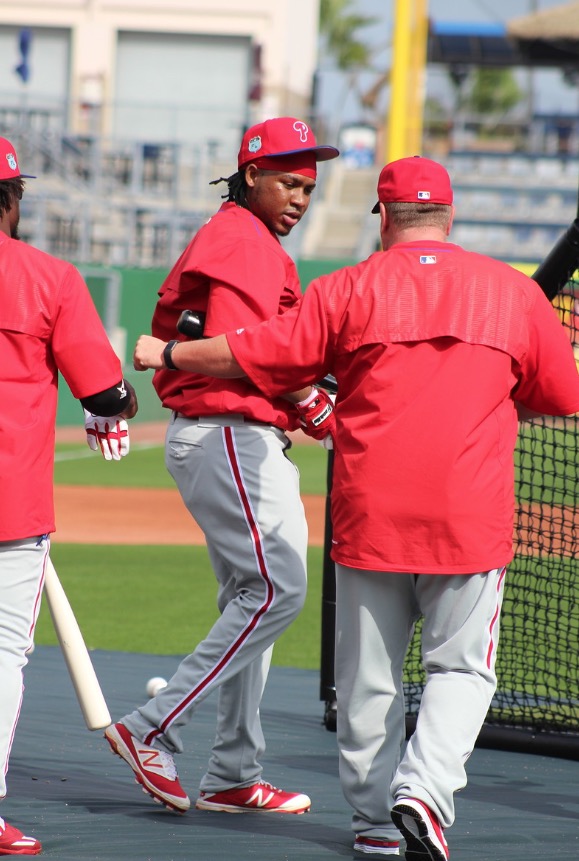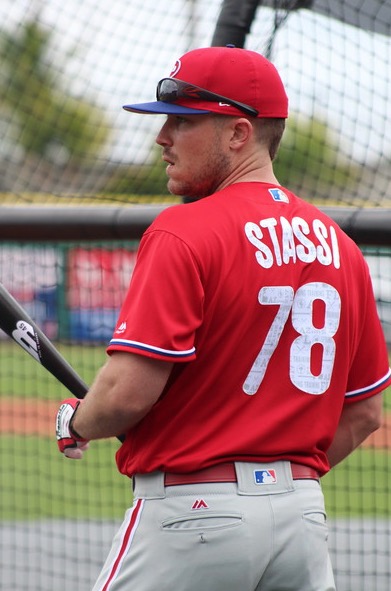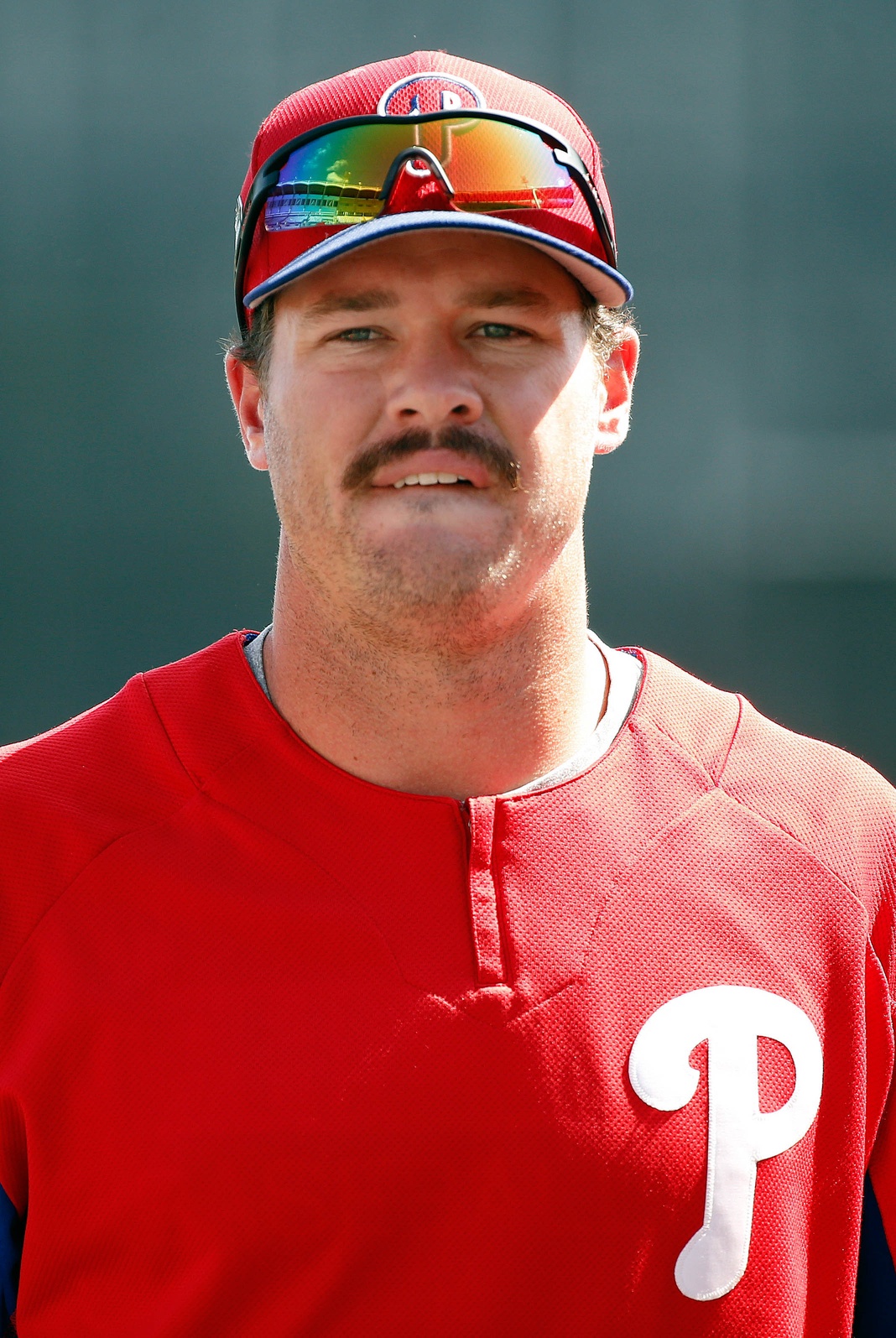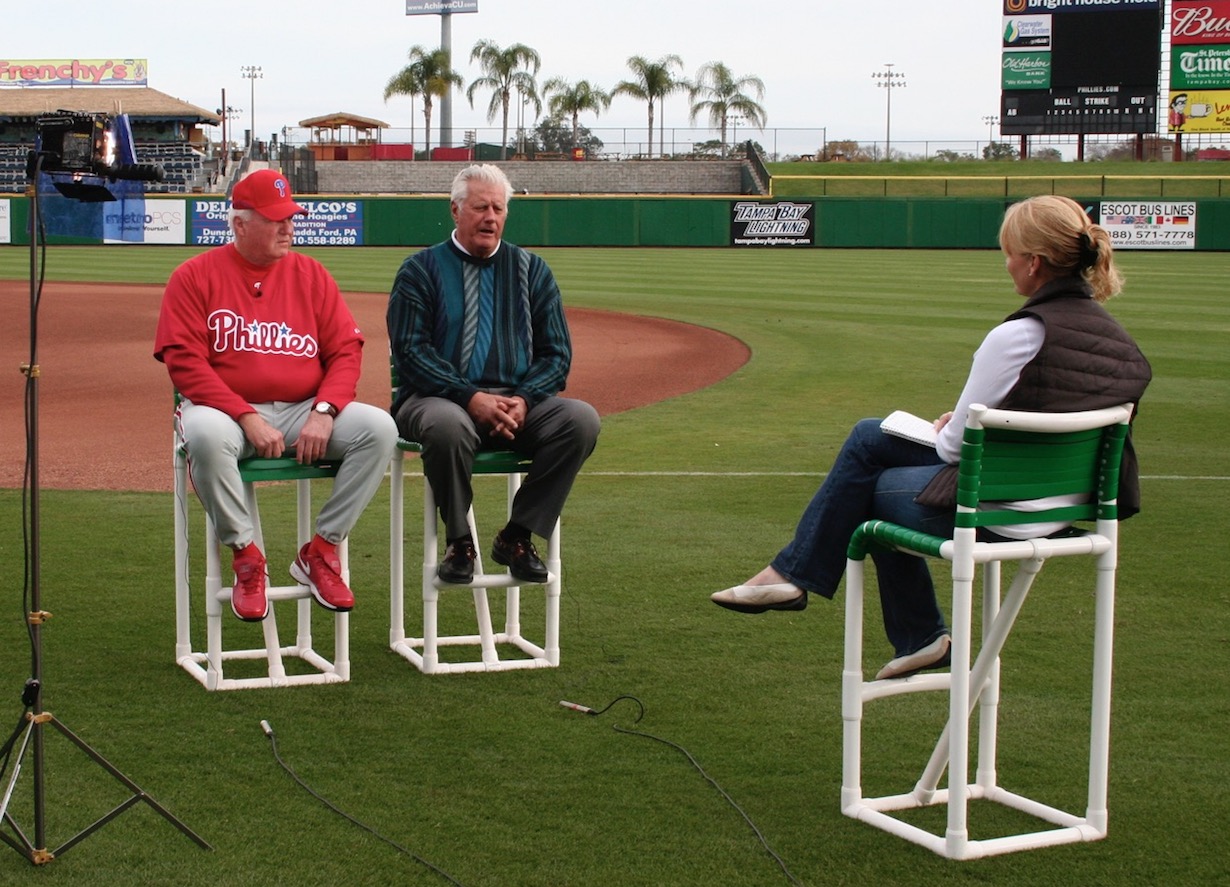Ad Disclosure
Phillies Roundup: Vince Velasquez, Maikel Franco, a Farewell to Dallas Green, and More
By Leslie Gudel
Published:
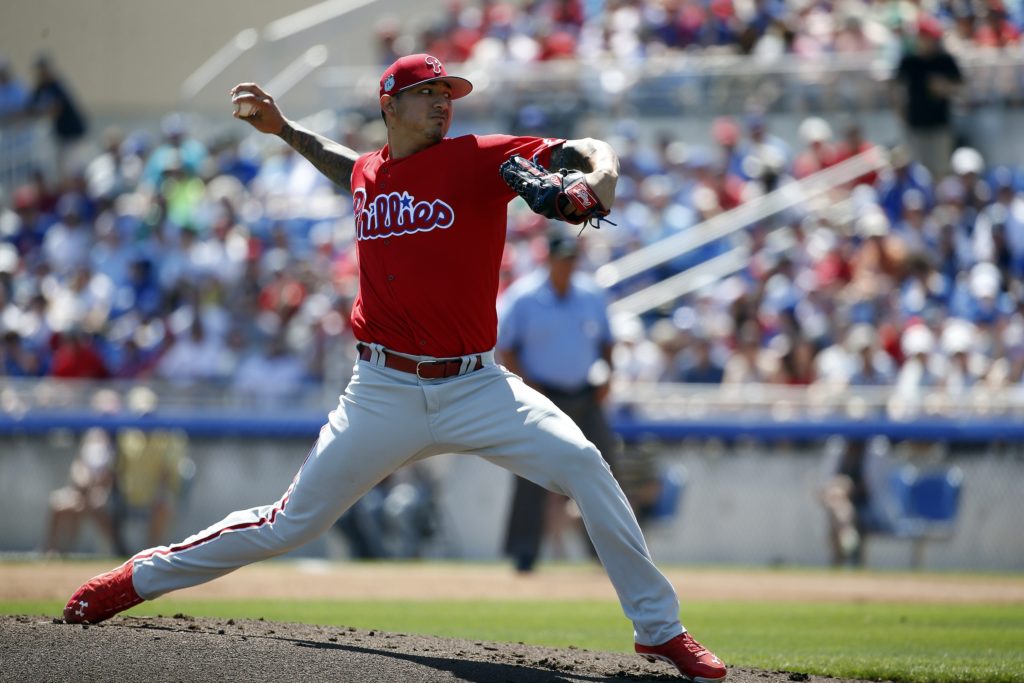
From thrower to pitcher
There are a number of intriguing storylines on this 2017 Phillies team. Among those Phillies fans will be watching closely is Vince Velasquez. Generally regarded as the most exciting pitcher to watch among the starting five, the flame-throwing right-hander showed a glimpse of his potential last April when he struck out 16 in a 3-0 complete game shutout over the Padres at Citizens Bank Park.
The game was a blessing and a curse. Fans wanted more of the same, so did Velasquez, but he never came close the rest of the season, getting as far as seven innings in only two of his following 22 starts.
Phillies pitching coach Bob McClure has been trying to harness what works for Velasquez without stifling his talent: “It’s like when you have a really high-bred dog, you can’t reign them in to the point to where they don’t feel athletic or… it’s almost gotta be like you gotta trick them into, it’s their idea. You know what I mean? It’s like we do with our kids.”
What worked for Velasquez in that game against the Padres is exactly what has worked for him every time he finds success: his four-seam fastball. 20 times in that game, San Diego swung and missed on it. According to MLB Statcast, Velasquez had the highest missed-swing rate on four-seam fastballs in 2016, ahead of guys named Verlander, deGrom and Scherzer.
In his final spring game against Toronto, Velasquez capped off his five-inning performance by striking out the heart of the order – including a 97-mph fastball to Jose Bautista to end the inning. McClure used Velasquez’s success in that game to drive home his point: “It’s like I was telling Vinny the other day, you’ve had maybe 10 3-2 counts where you’ve thrown a four-seam fastball and you’ve struck every one of them out. So, what’s that telling you? Use that! The last inning when we tell you, or you know it’s your last inning, what works for you in your last inning? Because that last inning of his is usually unreal. He throws way more four-seam fastballs in that last inning. Always. So, if that works for you, you need to learn from that.”
McClure’s words seem to be sinking in with Velasquez: “Against Toronto, I gave up a home run and five hits, but I still came up with the W. That shows that it’s not all about striking guys out. But if I’ve got two strikes on somebody, I’m going to put you away. So there’s a time to utilize that and there’s a time not to, so that’s where you’ve got to realize where you need to save your bullets and that’s where I got my learning experience by changing my whole mentality from being a thrower to a pitcher.”
Friends and foes
Find a baseball field anywhere and you’ll find kids who dream of making it to the big leagues someday. Only a few will actually get there. Even fewer will make it along with their teammate and best friend. In the slimmest of chances, the two will end up rooming together, despite being on two different teams. But, that’s exactly what happened this spring with Velasquez and Toronto Starter Aaron Sanchez.
The two former shortstops from Southern California used to compete for the same position on the same travel team in high school. They lived an hour apart from each other, but they’ve been best friends since their sophomore year of high school. Their families were friendly. They attended each other’s school events together.
The stars were aligned when both players were drafted in 2010. Sanchez went late in the first round (34th overall) to the Toronto Blue Jays. Velasquez was selected early in the second round by the Houston Astros. Velasquez: “He got drafted and I got drafted and we’ve kept that same relationship throughout the years. We call each other or Facetime throughout the year. It’s been a great journey still keeping that friendship.”
The stars collided this spring when the two friends had the opportunity to room together throughout Spring Training. Their respective teams are based about five miles apart, so every morning Sanchez would head west to the Blue Jays complex in Dunedin, and Velasquez would head south to Clearwater.
At night, the two were self-admitted homebodies and for all the right reasons. “Ever since we were little, we’ve stayed out of trouble, we really don’t go out and socialize and go to bars and stuff like that,” Velasquez said. “We’re focused on what we’ve got and what we have ahead of us and we know if we can plan for our future and do whatever we have to do now to plan for that, we’re going to do that.”
Then, during the final week of Spring Training, it happened: Velasquez and Sanchez got to pitch against each other in Dunedin. The Phillies right-hander won the pitchers duel, throwing five solid innings in the 7-1 win. Sanchez struggled with a blister on his finger and command issues, giving up five runs over five innings. This result was secondary to the moment Velasquez enjoyed most.
While he thought they might pitch against each other one day, he didn’t think he’d ever face his friend from the batters box. In Grapefruit League play, the AL uses a DH, while the pitcher hits for the NL team. That meant Velasquez would have to face his friend with a bat in hand, but not the other way around: “It was an interesting day. I went up to him and grabbed him by the shirt and said, ‘you’d better not hit me tomorrow, dude, I’m facing you.’ He kinda gave me a laugh of ‘you’re joking’ and I’m like, ‘I’m serious, you better not. You hit me, I know where you’re sleeping tonight, boy.’”
Velasquez relished the moment: “Before I got in the box, he laughed and then he saw me laughing and he told himself he couldn’t laugh or he would have just stepped off the mound and got really distracted. But, the competitive nature is always there. As soon as I hit that ground ball and ran to first base, he’s like, ‘you suck’ and I was like, ‘whatever, dude.’”
Both pitchers are finding success in the majors, with Sanchez outpacing Velasquez, so far. Sanchez won the AL pitching title with a league-low 3.00 ERA in 2016 and was also named to his first All-Star Game, but all indications are that Velasquez has his best years ahead of him and his childhood friend to lean on along the way.
Progress for Franco
Is this the year Maikel Franco breaks out? It’s set up for him to do just that. The Phillies went out and got a couple of veterans in Michael Saunders and Howie Kendrick, and that should help ease the pressure off a player who, last year, sometimes felt like he should be carrying the load for the rest of the team.
Franco: “Sometimes happens, sometimes it’s hard and sometimes you feel like.. but you know, when you saw your team has some trouble you want to go out there and do everything you can do for your team. But sometimes it’s hard.”
Matt Stairs intentionally put Franco in the same hitting group as Saunders and Kendrick this spring, so Franco could learn how a couple of professional hitters go about their business. Franco welcomed the wisdom: “Saunders and Howie, those guys, they come to me and talk to me about hitting and how you play the game the right way, so I feel really comfortable, cause they give me a lot of support, they’re close with me and talk with me.”
Franco has also felt the benefits of working with new hitting coach Matt Stairs: “Stairs, he’s the guy that I want to be with him, because I know him, he know about hitting and like I said, I want to get more information, try to learn more.”
Stairs says Franco has been a receptive student: “He told me many times, ‘Take what they give ya, take what they give ya,’ and I said, ‘Absolutely right, let’s limit the at-bats you give away.’ That’s one thing he’s trying to fix. He’s told me he’s tired of hitting weak ground balls to third base. So, he’s been working hard and he’s in a good spot right now.”
Altherr – take two
“He’s a five-tool player – he’s got power and speed, defense and all that stuff.”
That was Matt Stairs’ summary of what he thinks of Aaron Altherr. Altherr has arguably improved more than any other player under the new hitting coach’s guidance.
After impressing people following his mid-season debut in 2015, Altherr entered Spring Training in 2016 as a promising outfielder and part of the team’s plans. Instead, he injured his wrist, had surgery and missed most of the 2016 season. Even after his return in late July, Altherr had trouble regaining his form.
Enter Stairs: “What we did was, with lowering his hands, he’s getting into a position of being able to sit on the bench a couple days, come off and still have hit timing. I can see the confidence in him every time he takes the batters box knowing that he can hit the ball hard.”
Altherr made the team as a backup outfielder, so not getting thrown off by down time will be important. In limited games last year, Altherr said he didn’t have a feel for his swing. That’s all changed: “Just being relaxed at the plate has really helped me out a lot. I think I was getting a little too tense. I was gripping the bat a little too tight. I just lowered my hands a little bit and I just feel a lot more relaxed at the plate. I can see the ball a lot clearer. I’ll be breaking camp, this will be the first time in three years I’ll actually break camp from Spring Training, so I’m pretty excited about that.”
All business
Certainly the most sentimental storyline out of Spring Training was that of Brock Stassi. The former 33rd round pick in the 2011 draft has defied the odds and made it to the big leagues. While it was his bat that impressed, hitting .333 with six home runs in 57 at-bats this spring, it was something more that caught Stairs’ eye: “Love him. I mean he’s… for a guy that’s comes to big league camp for, I think the second time, the way he carries himself, the way he goes about his business… We’ve sat there many, many times and just talked about his approach to hitting and why his is different than a lot of guys… his technique. Great first baseman and he’s been a silent leader really, in the locker room. He’s a workhorse. He’s in the cage working. During batting practice he’s always talking hitting, always talking defense. He’s been an absolute joy.”
‘Stache story
Photo credit: Kim Klement-USA TODAY Sports
[soundcloud url=”https://api.soundcloud.com/tracks/315938308″ params=”color=ff5500&auto_play=false&hide_related=false&show_comments=true&show_user=true&show_reposts=false” width=”100%” height=”166″ iframe=”true” /]If you’re trying to decipher all the new faces on the Phillies this year, backup catcher Andrew Knapp will be easy to spot. He’s the dude with the stand-out ‘stache, and it may be here to stay.
Knapp said he first grew the mustache when he was in Double A Reading in 2015: “I started growing it and we started winning a lot of ballgames and I was having pretty good success at the plate and I kept it pretty much that entire season in Reading and then I kind of wanted that Juju to help me this year in Spring Training, to be honest. I think it’s paid off a little bit.”
As for his daily moustache grooming: “Yah, I think the dirtier the better, to be honest with you. Obviously there’s like “Just for Men” and stuff like that, that can make it look like really dark and stuff but we haven’t gotten there yet.”
Knapp jokes that he may not be able to shave if it’s how fans identify with him. He clearly doesn’t take himself too seriously: “I think it adds a little fun to the game. It can be really serious. People can take this game way too seriously, so it kind of adds a little fun and character to the game and people make fun of me for it, but that’s all right. That’s what it’s all about.”
Farewell to Dallas Green
I recall it vividly, Roy Halladay had just thrown a no-hitter against the Cincinnati Reds in game one of the 2010 NLDS and Dallas Green was in the clubhouse. A man who’d watched thousands of baseball games in his lifetime surely could offer some perspective on a game for the ages, so I asked him for an interview. What I didn’t expect is for Dallas to tell me he had attended the only game in baseball history that had done this game one better. Green was 22 years old when Yankees pitcher Don Larsen threw a perfect game against the Brooklyn Dodgers in game five of the 1956 World Series. He was sitting in the outfield bleachers. I’d bet there’s a good chance he’s the only person on this earth who was at both of those historic games.
Dallas watched, played and managed a lot of baseball in his life. 62 years, to be exact. At 6’5” with a booming voice, he had that larger-than-life presence. He was observant, too. We showed up at Spring Training one day having had a particularly fun night the night before. Dallas somehow knew. He said, “If you wanna dance, you gotta pay the fiddler.” I later found out it was one of his signature lines. He was also fond of asking his fellow Phillies employees, “What have you done to make the Phillies better today?”
Dallas made baseball better. I’ll miss him around the ballpark.
Leslie Gudel has covered sports for 23 years, more than 19 of those years spent in Philadelphia. Leslie's reported on everything from college football, the Indy 500 and the Little League World Series to figure skating and the pro bowlers tour, of all things. But, her first love has always been baseball and she's covered the Phillies since Terry Francona was in town. You'll find her podcast, "Inside Corner", on iTunes and Google Play beginning in late March.
